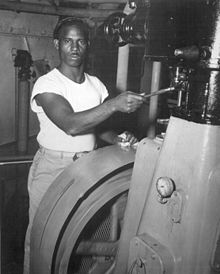- Oiler (occupation)
-
An oiler is a worker whose main job is to oil machinery. In previous eras there were oiler positions in various industries, including maritime work (naval and commercial), railroading, steelmaking, and mining. Today most such positions have been eliminated through technological change; lubrication tends to require less human intervention, so that workers seldom have oiling as a principal duty. In the days of ubiquitous plain bearings, oiling was often a job description in and of itself.
Today, shipping is the economic segment that most thoroughly retains the notion of the oiler as a separate position. On a merchant ship, an oiler is an unlicensed member of the engineering department. The position is one of the most junior crewmembers in the engine room of a ship. The oiler is senior only to a wiper.
As a member of the engineering department, the oiler operates and maintains the propulsion and other systems on board the vessel. Oilers also deal with the "hotel" facilities on board, notably the sewage, lighting, air conditioning, and water systems. They assist bulk fuel transfers and require training in firefighting and first aid. Moreover, oilers help facilitate operation of the ship's boats and other nautical tasks- especially with cargo loading/discharging gear and safety systems. However, the specific cargo discharge function remains the responsibility of deck officers and deck workers.
A person has to have a Merchant Mariner's Document issued by the United States Coast Guard in order to be employed as an oiler in the United States Merchant Marine. Because of international conventions and agreements, all oilers who sail internationally are similarly documented by their respective countries.
To work as an oiler in the Canadian Coast Guard, it is required that the individual holds an engine room rating certificate. In order to obtain this certificate the applicant must first have no less than 6 months of documented sea time working under the supervision of a watch keeping engineer. The applicant must then go to a Transport Canada Office and have a written and oral exam before the certificate is issued. It is also required for all sea going personnel to have MED (marine emergency duty) certificates which can be obtained by taking courses through a college approved for training.
Oilers working for the Canadian Coast Guard have various duties, some of which include, performing regular maintenance of the ship's engines and other equipment, assisting the engineers with the repair and overhaul of the ship’s engines and equipment, making regular rounds of the engine room and designated spaces and alerting the engineer on watch of any problems noted. The oiler is also required to keep the engine room clean, tidy and freshly painted. They are the most junior crewmember of the engineering department in the Canadian Coast Guard.
Contents
Tools
- Oil cans (which themselves are sometimes referred to as "oilers")
- Grease guns
- Rags and brushes
See also
- Seafarer's professions and ranks
- Engine room
- Engineering department
- Qualified Member of the Engine Department
- Ring oiler
- Wiper (occupation)
References
External links
Deck department Engine department Steward's department Licensed: PurserCategories:- Marine occupations
- People in the petroleum industry
Wikimedia Foundation. 2010.

